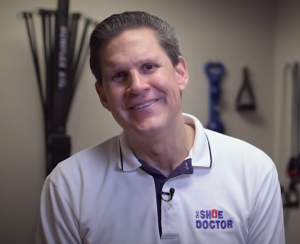So what’s the difference between custom and over-the-counter orthotics? Custom orthotics are created from a mold or scan of your foot, so they’re tailored to the shape and requirements of an individual. Over-the-counter orthotics are standard sizes and shapes, so they fit most feet but might not provide the same support. Custom orthotics are great for individuals with niche requirements or foot discomfort caused by issues such as flat feet or high arches. Custom orthotics work best for moderate to severe pain or where underlying biomechanical issues need to be corrected. In order to determine which is best, individuals should consider their symptoms and consult with a medical professional.
Key Takeaways
- Getting to the core of the differences between custom and OTC orthotics is key to finding the best fit for your unique feet and future health.
- Custom orthotics provide personalized support derived from expert analysis, ideal for addressing nuanced and persistent issues, whereas OTC orthotics deliver a standard fit and cater well to minor or short-term pain.
- Custom orthotics tend to be made with higher-quality materials, and are more durable, so they ultimately provide better long-term value — particularly for those with specialized biomechanical needs.
- Cost is big – custom orthotics tend to be more expensive up-front and sometimes covered by insurance, while OTC solutions are less costly initially but might need to be replaced frequently.
- See a professional – such as a podiatrist – to get the correct diagnosis and best orthotic solution, as you risk exacerbating foot problems with misuse.
- Carefully evaluating your personal symptoms, activity levels, and budget will help you make an informed decision that supports both immediate comfort and lasting foot health.
When To Choose OTC
OTC orthotics provide an easy fix for those who experience occasional foot pain, require additional padding, or desire short term alleviation from minor foot ailments. OTC inserts are widely available, simple to experiment with, and can help bolster everyday activity or workouts for patients without significant foot dysfunction. They offer a convenient access point for customers who like to sample comfort or support prior to investing bigger.
Mild Discomfort
Price is a genuine issue for a lot of folks. OTC orthotics typically cost significantly less up front than custom-made counterparts, and are a go-to for the budget conscious. There are lots of affordable options out there, from simple foam pads to gel inserts, making it more likely that you can find something that suits you and your budget. For low level pain, like soreness from long walks or standing all day at work, these products provide a quick fix without the costly hit.
Budgetary Needs
OTC orthotics provide individuals an opportunity to experiment with what makes sense in terms of support. Feel free to experiment with brands, materials, and shapes to find what provides optimal comfort for your feet. This adaptability allows you to trade styles if one falls flat, and adapt fast if your activity shifts. Throughout the experiment, it’s essential to monitor how your feet are feeling—be it pain, relief or anything in between—and leverage that feedback to determine what to try next.
Trial Period
Certain ailments, such as high arches, flat feet, or persistent pain, might not be alleviated with OTC orthotics. Customs are usually reserved for those with persistent or intense pain, as they are crafted to accommodate unique foot contours and can outlive the average one-year tenure of OTC versions. Professional help is important for anyone in doubt, because the incorrect insert can postpone actual therapy and exacerbate symptoms. For persistent pain, custom orthotics offer more support and could avoid future issues.
When OTC Is Sufficient
If you don’t have some major foot problems, OTC orthotics might be enough. They’re great for minor aches and pains, provide extra cushioning for athletics, and assist with everyday activities. If pain lingers or worsens, it’s crucial to have a doctor examine it.
When To Choose Custom
Custom orthotics are for those whose requirements exceed what you can get over the counter. They’re designed for people with chronic foot pain, abnormal foot shape or medical conditions. For those with high arches, flat feet, or a past occurrence of diabetic foot ulcers–custom orthotics will give you relief and help you avoid future problems. They’re a great fit for athletes who require specialized support to mirror their sport’s requirements.
Specific Conditions
Custom orthotics correct biomechanical issues impacting the function of your feet. For instance, plantar fasciitis and arthritis typically lead to pain and strain where the arch meets the heel. Custom molds to your individual foot’s curve or flatness, providing support where off-the-shelf insoles can’t.
Beyond comfort, custom orthotics aid in overpronation, the roll of the foot too far inwards during walking. That can cause knee, hip, or even back pain if left uncorrected. Flat-footers or those with ultra-high arches require orthotics that are customized to their foot’s anatomy. The proper fit optimizes your gait, prevents premature wear and tear on joints, and can even alleviate ankle or knee pain. Over time, they help stop minor foot issues from becoming chronic.
Biomechanical Issues
Visiting a foot doctor is just as important before purchasing an orthotic. Just a qualified expert, such as a podiatrist or orthotist, can examine your foot’s anatomy and walk style. They take these exams to determine what type of orthotic suits you.
Podiatrists are trained to identify underlying problems that OTC insoles can’t address. They can recommend custom for the individuals who haven’t had relief with over-the-counter options. With their continued attention, you receive support that endures, keeping your foot health in line.
Professional Advice
The wrong orthotic can equal more pain, not less, over time. Good insoles can help bad ones and can make it worse – the right custom fit is an investment in comfort.
Multiple such treatments for persistent foot pain can add up to quite expensive. Custom orthotics, constructed from durable substances, can last for years.
Long-Term Considerations
Custom orthotics heal and prevent pain from returning.
They can cost you less headache in the end.
They work better for hard-to-treat foot conditions.
They give better results for those with special needs.
The Hidden Costs of a Wrong Choice
Deciding between custom and OTC orthotics isn’t simply a matter of the initial cost. The real cost is in how good a fit each option is for your feet and your life. People often opt for OTC insoles because they’re easy to obtain and appear inexpensive. These are typically foam or gel based and only last around one year. This means you end up buying new pairs every few months, which adds up. The lower price may seem appealing initially, but if these inserts don’t provide sufficient support, you may experience increased pain or injury, resulting in more doctor visits and expenses.
Custom orthotics are significantly pricier—running anywhere from $200 to $800, with insurance often not covering the total expense. Even with insurance, folks can still pay 10–50% out of pocket. That’s not even including bringing these inserts back to the surface which can run an additional $50-$100. Custom devices, while molded to your feet and more durable, aren’t necessarily the best solution for all. Others don’t get relief, some even experience pain, resulting in more doctor visits and additional money spent. A study came out last year that found that prefab, or non-custom, orthoses can work just as well as custom ones for certain ailments. This is to say: not all foot issues require a bespoke remedy, and higher prices don’t necessarily equal better results.
It’s crucial to consider your health requirements, your daily activities, and the amount of support your feet require. Folks who walk heavily for their jobs or suffer foot pain from underlying health problems may require more support than OTC insoles can provide. A personalized contraption might be overkill for someone with moderate aches. The wrong choice can translate to wasted cash, bad foot health, and additional time searching for a solution. You’re smart to seek assistance from a podiatrist or specialist who can advise you on your foot type, health, and daily requirements. It’s not about penny-pinching, it’s about discovering what will keep you mobile and vibrant.

Making Your Decision
Deciding between custom orthotics and over-the-counter insoles is ultimately a matter of aligning your needs with the advantages of each type. The primary consideration should be your own degree of foot soreness. Custom orthotics are best for moderate to severe pain, or for individuals with an existing foot issue. For instance, if you have flat feet, plantar fasciitis, or a significant deformity, a tailor-made device from a specialist might provide superior outcomes. These are crafted to your foot shape and walking style, so they can assist with complex problems such as gait misalignment. Instead, OTC insoles are designed to respond to broader needs and may fit individuals who experience mild discomfort following standing or light activity.
Custom orthotics are far more expensive than their mass-produced cousins, but many consider them a permanent solution. A runner with persistent heel pain may opt for custom orthotics to continue training. If you’ve got a minor, short-term injury or just want to test out whether some added support is beneficial, a simple store insole may suffice. In both instances, what you pay typically corresponds with both the fabrics and the fit level. Custom orthotics utilize superior materials and can perform for a couple of years, whereas retail insoles tend to wear out quicker and need to be replaced more frequently.
For athletes, the decision is a mix between activity and risk. A weekend walker may be fine with a basic insole, but a football player with nagging pain could require the custom fit and added support of a specialized device. Others try an OTC insole first to test if support is helpful, then graduate to custom orthotics if they require something more. A health provider can examine your foot and gait to assist in your decision.
OTC insoles make sense for short-term use. For example, if you’re a frequent traveler or stand at work, these insoles are easy to purchase and wear for a few weeks or months.
Conclusion
Custom vs. Over-the-counter orthotics both alleviate foot pain, but suit different requirements. Custom orthotics fit your feet and correct your steps. Over-the-counter ones provide basic support for minor discomfort or infrequent use. Choosing the wrong one can waste money or introduce new problems, such as sore joints or bad posture. Real-life anecdotes tell us that some users experience rapid relief with the ideal choice, while others suffer increased pain from an ill-fitting model. To hit the bulls-eye, consider your aches, your miles, and your money. Consult a podiatrist if you feel uncertain. Post your own story or ask a question below–someone here might know exactly what you need.
Frequently Asked Questions
1. What are orthotics used for?
Orthotics assist to support, align, or enhance the efficiency of your feet. They can relieve pain, correct posture and prevent injuries to individuals with foot or leg ailments.
2. How do custom orthotics differ from over-the-counter orthotics?
Custom orthotics are created for your feet after a medical evaluation. OTC orthotics are pre-fabricated and conform to generic foot shapes, providing minimal cushioning.
3. When should I choose over-the-counter orthotics?
So, for instance, OTC orthotics are fine for mild pain, short-term use, or general support. They’re less expensive, and readily available in pharmacies or online.
4. When are custom orthotics recommended?
Custom orthotics work best if you have chronic pain, an atypical foot shape, or a particular medical issue. They offer personalized support and are recommended by a medical professional.
5. Are custom orthotics worth the higher cost?
Custom orthotics might be pricier, but they provide accurate fit and specific assistance. This can help to avoid additional damage and decrease long-term medical expenses.
6. Can I use orthotics without a prescription?
You can purchase and use OTC orthotics without needing a prescription. Custom orthotics need an evaluation and prescription from a health care provider.
7. What are the risks of choosing the wrong orthotic?
An incorrect orthotic can exacerbate your pain, give you new foot issues, or just throw your money down the drain. Really, pick what works for you and ask the experts if you’re unsure.
Stop Letting Foot Fatigue Slow You Down — Get Relief With Custom Orthotics From The Shoe Doctor
If your feet feel sore, heavy, or worn out after a long day, custom orthotics could be the game-changer you’ve been looking for. Whether you’re on your feet for work or daily errands, fatigue often comes from poor support, uneven pressure, and misalignment. Our custom orthotics are built to correct those issues—supporting your arches, improving posture, and helping you stay energized throughout the day.
At The Shoe Doctor, we’ve spent over 20 years creating orthotics that do more than cushion your feet—they target the root causes of pain and fatigue. Using advanced 3D foot-mapping technology, Russell designs orthotics tailored to your foot structure and walking style. Through our partnership with the Spine & Injury Medical Center in San Jose, we also take your overall body mechanics into account to support lasting results.
Located in the South Bay Area? Book your free consultation today and see how custom orthotics from The Shoe Doctor can help you move with comfort, confidence, and less fatigue.
Disclaimer
The materials available on this website are for informational and entertainment purposes only and are not intended to provide medical advice. You should contact your doctor for advice concerning any particular issue or problem. You should not act or refrain from acting based on any content included in this site without seeking medical or other professional advice. The information presented on this website may not reflect the most current medical developments. No action should be taken in reliance on the information contained on this website, and we disclaim all liability for actions taken or not taken based on any or all of the contents of this site to the fullest extent permitted by law.


